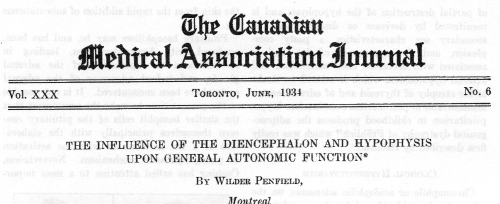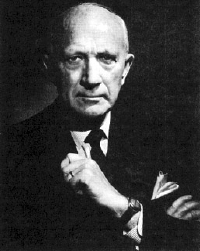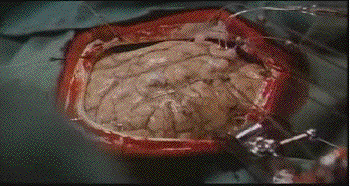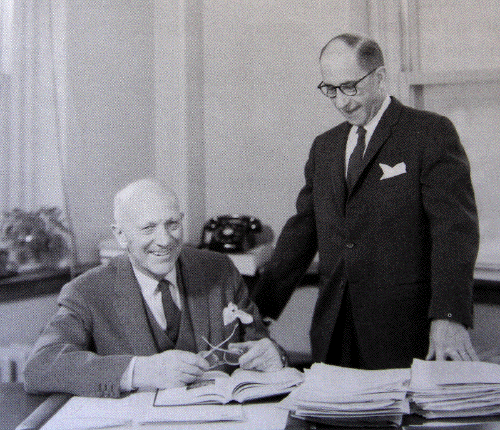-
- Les
biographies de
neurologues
-

-
- The diencephalon
- The diencephalon (called also interbrain, or
tween brain), surrounding as it does the third
ventricule and including thalamus, hypothalamus
and infudibulum, is a very old portion of the
brain, being well developed in the lowest
vertebrate forms which possese little or no
forebrain. Without daring to stop for a detailed
anatomical discussion I may point out only that
lying beneath the walls of the third ventricle
are supraoptic nuclei and nuclei of the tuber
cinereum which seem to be closely associated
with the posterior lobe of the pituitary, being
connected with each other by afferent and
efferent fibres. This complex Beattie has
labelled the anterior mechanism. He might
perhaps have borrowed from Cushing the term
"neurohypophyseal" mechanism. There is some
evidence that this anterior group of nuclei may
deserve the adjective "para-sympathetic" because
of the relationship of the tuberal nuclei to the
craniosacral division of the autonomic nervous
system with its peripheral control through vagus
and pelvic nerves.
-
- The posterior group of nuclei located in the
walls of the posterior portion of the third
ventricle above the corpora mammillana are said
to contain the sympathetic centres. Efferent
tracts, composed of short neurones which pass
downward through brain stem and cord, are
assumed for both anterior and posterior
complexes, but in the ease of the posterior
group a sympathetic pathway was actually
followed by Beattie, Brow and Long' from this
region down the posterior longitudinal bundle
and cervical cord, through the second, third and
fourth thoracic anterior roots to the stellate
ganglion and thence to the heart. The afferent
tracts so far demonstrated to these centres are
chiefly derived from the diencephalon and from
the forebrain. It seems somewhat surprising that
the afferent pathways should come from
"headward" regions. It may be that forebrain and
thalamus form stations on the pathway from
periphery to hypothalamic centres, but it is
also evident that what may be considered
afferent impulses reach these centres through
the blood stream. For example, if the blood
entering the thalamus be raised above the normal
temperature there is a response from the nervous
mechanism in the vicinity which results in a
discharge, chiefly parasympathetic, which lowers
the general temperature by sweating,
vasodilatation and diminished oxidation.
-
- Attention must be called also to the
existence of a portal system of veins which is
said to pass upward from both anterior and
posterior lobes of the hypophysis through the
infundibulum (Popa and Fielding; see also Basir,
1932), where they break up into a secondary
distributing net beneath the infundibular recess
of the third ventricle. Further, a colloid
substance has been described in these veins by
Collin," also by Popa and Fielding," and by
Cushing.' If this proves to be true much of the
hormonal material from the pituitary may act
directly upon the nervous system. But Espinasse"
has most recently urged that these vessels are
arteries, not veins, and fails to find colloid
material in them. There is, in any case, a
partial drainage into the general circulation by
way of the cavernous sinus, which is derived
chiefly from the sinusoids in the anterior lobe.
Innervation of the posterior lobe is by nerve
fibres from supra-optic and tuber nuclei, while
the anterior lobe is innervated by fibres
derived from the carotid plexus (Dandy).
-
- CASE 1
-
- In January, 1928, I was fortunate enough
to have under my care at the Presbyterian
Hospital in New York a patient with a small,
discrete, encapsulated tumour so placed that it
impinged upon the anterior and superior portion
of the thalamus of each aide. She was subject to
recurring seizures which resembled epileptic
attacks, excepting that the manifestations of
the attack were confined to the realm of the
autonomic nervous system. The case was published
under the heading "Diencephalic autonomic
Epilepsy".
-
- Now, an epileptic discharge is a gross
revelation of the function of an area, somewhat
in caricature no doubt, but the true features of
function are there to be scanned (Jackson) by
him who can read. The epileptic phenomena which
I shall recount in order of their habitual
appearance may therefore reveal to us the
function of this region. We may think of the
disturbance spreading downward and backward from
the tumour site.
-
- 1. Prodromal restlessness and sometimes a
desire to void.
- 2. Sudden intense dilatation of skin of
face, arms and breasts. Sudden rise in the blood
pressure from 110 up to 200.
- 3. Lacriniation; diaphoresis; salivation;
dilatation (or contraction) of pupils;
protrusion of eyes (not invariably present);
increase of rate and of pressure of pulse;
marked retardation of respiratory rate;
elicitability of pilomotor reflex.
- 4. Disappearance of superficial blush and
fall of blood pressure; slowing and weakening of
pulse.
- 5. Hiccups (from 3 to 5 in number).
- 6. Transient shivering.
-
- During the present year I have had under my
care at the Royal Victoria Hospital 3 other
patients who showed certain features of
autonomic epilepsy. One of these may be
mentioned here.
-
- CASE 2
-
- A woman of 29, with a tumour involving
the under surface of the left temporal lobe and
extending to the midbrain and thalamus. She had
had recurring slight attacks consisting of
sudden headache, followed by
yawning
and hiccuping and sometimes associated with
patchy erythema in different areas of the body.
There was one attack of greater severity,
characterized by a rise of blood pressure to 200
over 90, whereas the usual level approximated
100 over 70. With this there was a simultaneous
rise of the pulse rate to 120, flushing and
appearance of irregular erythema over the chest
and thighs, spontaneous appearance of "goose
flesh", slowing of the respirations to 4 per
minute, salivation, lacrimation, dilatation of
the left pupil, and contraction of the
right.
-
- This description tallies sufficiently with
the first to make it clear that we are not
dealing with a discharge of a parasympathetic
system alone, as Cushing concludes in reviewing
the first ease. It is an explosive,
undiscriminating, discharge which betrays the
spatial relationships both of parasympathetic
and sympathetic function. The dilatation of the
peripheral vessels and sweating might be
considered as parasympathetic in nature, but the
pilomotor response and increased pulse rate,
increased blood pressure, and protrusion of the
eyes obviously belong in the sphere of the
sympathetic. Another instance may be cited.
-
- CASE 3
-
- In the case of a boy of 14 I approached a
tumour of the third ventricle through the right
lateral ventricle under nupercaine analgesia.
Taking hold of the tumour as it presented in the
foremen of Monro I moved it within the third
ventricle. The patient "hummed" and then vomited
in a projectile manner, after which there was
generalized shivering, followed by sudden
frantic scratching of the inner aspect of the
left thigh and there appeared very marked
reddening of that skin area. Following this he
became disoriented as to place. His temperature
rose from 99 at the time of the shivering to
102e an hour and a half later. This boy returned
to our clinic last week, nine months after
operation, complaining of generalized urticaria.
His papilloedema had disappeared and he seemed
well in other ways.
-
- In the light of the operative findings and
the sudden erythema seen at operation it seems
justifiable to suggest that his urticaria is due
to some recurrence of the tumour in the wall of
the third ventricle.
- It is recognized that the urticarias and the
general reaction, for example after serum
injection, do not occur if the patient is
anesthetized. It may well be that such reactions
proceed from the autonomic centres which I have
described.
-
- The conclusion to be drawn from these cases
of autonomic epilepsy is that there are
represented in the diencephalon blood pressure
control, heart rate control, vascular
dilatation, sweating, salivation, lacrimation,
control of respiration, pilomotor reactions,
shivering, hiccuping and
yawning, and
perhaps micturition and the production or
urticaria.
-
- Experimental physiologits have timidly
pushed localization of autonomic function upward
from spinal cord and bulb to mesencephalon until
finally they also have burst into the
diencephalon with enthusiastic abandon.
-
 -
- Né à Spokane dans
l'État de Washignton, aux
États-Unis, il arrive au Canada en 1928.
Il se joint par la suite à
l'équipe de chercheurs de l'hôpital
Royal Voctoria de Montréal. Ses
recherches portent surtout sur le traitement de
l'épilepsie. Avec un don de 1 million de
dollars reçu de la fondation Rockfeller,
du gouvernement du Québec et de la ville
de Montréal, il fonde en 1934 l'Institut
de neurologie de Montréal. Cet
établissement est associé à
l'Université McGill. L'Institut de
neurologie de Montréal, qu'il dirige
jusqu'en 1960, devient un centre international
pour la recherche, l'enseignement et le
traitement des maladies du systèmes
nerveux.
-
- Dr.
Wilder Penfield revolutionized the
techniques of brain surgery and made major
discoveries about human cognition, memory and
sensation.
-
- Penfield's medical exploration began with
the causes and treatment of epilepsy, which was
considered incurable. In 1935 he set up the
Montreal Neurological Institute, which brought
together surgeons and scientists for cooperative
projects in the research, diagnosis and surgical
treatment of brain disorders.
-
- At the Institute, Penfield perfected his
"Montreal
Procedure." Applying only a local
anaesthetic, he would probe the exposed brain
tissue. Guided by the responses of the patient,
Penfield would search for the scarred tissue
that caused the epilepsy. This procedure also
revealed specific functions performed by various
unmapped regions of the brain. Penfield
discovered the source of memory, tapped the
reservoir of long forgotten sensations and
emotions, and located the storehouse of dreams.
See
the video
-
 -
- Improvements
in brain tumor surgery: the modern history of
awake craniotomies
- Ketan R. Bulsara et al.
Neurosurgical Focus 2005; 14; 4;
1-5
- Dr.
Wilder Penfield révolutionna les
techniques de chirurgie du cerveau. Il est
l'auteur de découvertes importantes
portant sur la mémoire, la
sensibilité et la douleur, la
cognition.
-
- Ces travaux commencèrent en
recherchant la cause et le traitement
d'épilepsies jusqu'alors incurables. Il
fonda l'Institut neurochirurgical de Montreal en
1935, original par l'association de chirurgiens,
physiologistes et chercheurs au sein de la
même structure vouée tant à
la recherche, qu'aux diagnostics et aux
traitements de la pathologie
cérébrale.
-
- C'est à l'Institut que Penfield
perfectionna "la
procédure montréalaise".
Recourant à la seule anesthésie
locale, il enlevait le volet osseux, mettant
à nu le cerveau. Guidé par les
réponses du patient, il recherchait la
région génératrice des
crises. Cette technique lui permit aussi
d'apporter sa contribution à l'ère
des localisations cérébrales tant
pour la mémoire que pour les
émotions. Voir
la vidéo.
-
- Andy
OJ, M Jurko Diencephalic Seizure Appl
Neurophysiol 1983; 46; 62-67
- Flechter S; Cohen
F; Borenstein F; Regev I; Vardi J; Yawning
as a paroxysmal sign of diencephalic seizures.
Archivio di Psicologia Neurologia e Pichiatria
1982; 43; 45-54
- Penfield
W, Jasper H Diencephalic autonomic seizures
Eplilepsy and the functionnal anatomy of the
human brain Little Brown et copany - Boston
1954
- Penfield
W The influence of
the diencephalon and hypophysis upon general
autonomic function
- Walusinski
O Yawningas aparoxysmalsignof diencephalic
seizures an original observation
-
-
 - Wilder Penfield (left) and William
Cone
- Royal Victoria hospital
1932
-
 - Wilder Penfield and Herbert Jasper
1954
|






